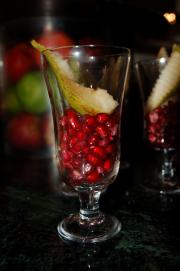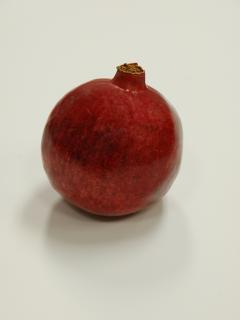Pests and diseases
Pomegranates have few pest and disease problems.
Mediterranean fruit fly occasionally causes damage where the fruit is cracked and a baiting program may be needed. The presence of this pest in Western Australia means that whole fruit cannot be exported to countries where this pest is not found.
Aphids can result in a twisting of young shoots and leaves. Scale insects can damage the leaves and stems.
Parrots will attack the fruit if the shell is cracked.
Rats can damage the fruit.
Root-knot nematodes can damage the roots.
Heart rot is often found in parts of the fruit and this is not obvious until the fruit is opened. It is believed to be caused by the fungal pathogen, Alternaria sp. which initially attacks the flower. It is difficult to control.
Weeds
Mowing or spraying to manage weeds is preferred to cultivation in older plantings to avoid root damage. Planting or a cover crop mixture of legumes and grasses in the inter-row is advisable to manage weeds and improve soil structure.
In the plant rows, apply glyphosate around the bushes, but avoid spray drift onto the leaves of the bushes, especially with young plants. This is a contact, non residual, herbicide that will kill most existing weeds. For grass control , use grass specific herbicides that are regisiteed to control existing weeds. Check the Australian Pesticides and Veterinary Medicines Authority's (APVMA) PubCris and minor use permit databases for pesticides that are registered or covered by a minor use permit to allow use on pomegranates in Western Australia. (see link on this page).
Fruiting
Pomegranates have attractive flowers which bloom for a long time from late spring to summer. Flowers occur on spurs of two to three-year wood and also on new wood.
Pomegranates are self- and cross-pollinated.
The fruit is a false berry. It consists of many close-packed red grains (arils), and segments which are separated by a non-edible white pith. The arils contain a seed surrounded by an edible juicy pulp. Fruit consists of 78% water, 8–21% sugars, 1.3% protein, 0.9% fat and 0.3–0.5% acid.
Plants do not commence to bear well until the third to fourth year after planting. Fruit matures from March to May.
Fruit is easily bruised and should be carefully handled. It will crack when too mature, or if there is too much rainfall in autumn, high humidities, poor watering, or high winds.
Pick the fruit with clippers, just before before the fruit has started to crack. The fruit should make a metallic sound when tapped. Clip the stem close to the fruit. The fruit will not ripen off the bush. Mechanical harvesters are not available for pomegranates.
Yields are 10 to 20t/ha, with 100 to 200 fruits per plant.
Pomegranates will store for about one or two months at ambient temperatures, or keep for seven months at 0–5°C and 80–85% relative humidity. The fruit improves in storage, becoming juicier and more flavoursome
Pomegranate bushes are long-lived.
Uses

Pomegranates contain a high level of polyphenols or anti-oxidants and are now being promoted as a health food, especially for the juice market.
Overseas, pomegranates are often marketed not as whole fruit as in Australia, but as arils or juice.
Machines are available from Israel to remove the arils and process 16 pomegranates per minute with only a low level of damaged arils. Fruit is held in cool storage before the arils are extracted. With vacuum packaging, arils can be stored for six months.
Pomegranate juice can easily be extracted from the separated arils. There are existing markets for juice locally and internationally. Juice content of fruit ranges from 45 to 65%.
The juice is also used to produce grenadine, which is used in cocktails and to produce wine. Grenadine was traditionally a mixture of pomegranate juice, water and sugar, but modern versions may be based on corn syrup and artificial colourings. After extraction of juice, the waste material can be used for pharmaceuticals and cosmetics.
Acknowledgement
This article is based an an earlier version prepared by John Burt.

